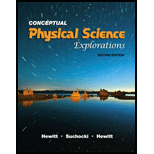
The charges with sodium chloride are all balanced - for every positive sodium ion there is a corresponding negative chloride ion. Since its charges are balanced, how can sodium chloride be attracted to water, and vice versa?
sodium chloride be attracted to water, and vice versa. When the charges with sodium chloride are all balanced - for every positive sodium ion there is a corresponding negative chloride ion.
Answer to Problem 18TE
The water is attracted to an individual ion of sodium chloride by ion-dipole forces.
Explanation of Solution
The water molecule gets considered as polar molecule containing two hydrogen-oxygen bonds and thus can exhibit a dipole nature in a molecule.
The sodium chloride is basically an ionic compound produced from individual sodium and chloride ions through electrostatic force of attraction. Thus, sodium chloride functions as polar molecule too.
As a water molecule comes closer to the sodium chloride molecule, it gets dissociated into various ions like sodium ion as well as chloride ion. Here the intermolecular force of attraction will exist between the polar molecule and the positively as well as negatively charged ions. The water molecule and these individual ions are attracted to each other through ion-dipole forces.
Conclusion:
Therefore the water is attracted to an individual ion of sodium chloride by ion-dipole forces.
Chapter 18 Solutions
Conceptual Physical Science Explorations
Additional Science Textbook Solutions
University Physics (14th Edition)
Essential University Physics: Volume 1 (3rd Edition)
College Physics: A Strategic Approach (3rd Edition)
Physics (5th Edition)
Introduction to Electrodynamics
Sears And Zemansky's University Physics With Modern Physics
 College PhysicsPhysicsISBN:9781305952300Author:Raymond A. Serway, Chris VuillePublisher:Cengage Learning
College PhysicsPhysicsISBN:9781305952300Author:Raymond A. Serway, Chris VuillePublisher:Cengage Learning University Physics (14th Edition)PhysicsISBN:9780133969290Author:Hugh D. Young, Roger A. FreedmanPublisher:PEARSON
University Physics (14th Edition)PhysicsISBN:9780133969290Author:Hugh D. Young, Roger A. FreedmanPublisher:PEARSON Introduction To Quantum MechanicsPhysicsISBN:9781107189638Author:Griffiths, David J., Schroeter, Darrell F.Publisher:Cambridge University Press
Introduction To Quantum MechanicsPhysicsISBN:9781107189638Author:Griffiths, David J., Schroeter, Darrell F.Publisher:Cambridge University Press Physics for Scientists and EngineersPhysicsISBN:9781337553278Author:Raymond A. Serway, John W. JewettPublisher:Cengage Learning
Physics for Scientists and EngineersPhysicsISBN:9781337553278Author:Raymond A. Serway, John W. JewettPublisher:Cengage Learning Lecture- Tutorials for Introductory AstronomyPhysicsISBN:9780321820464Author:Edward E. Prather, Tim P. Slater, Jeff P. Adams, Gina BrissendenPublisher:Addison-Wesley
Lecture- Tutorials for Introductory AstronomyPhysicsISBN:9780321820464Author:Edward E. Prather, Tim P. Slater, Jeff P. Adams, Gina BrissendenPublisher:Addison-Wesley College Physics: A Strategic Approach (4th Editio...PhysicsISBN:9780134609034Author:Randall D. Knight (Professor Emeritus), Brian Jones, Stuart FieldPublisher:PEARSON
College Physics: A Strategic Approach (4th Editio...PhysicsISBN:9780134609034Author:Randall D. Knight (Professor Emeritus), Brian Jones, Stuart FieldPublisher:PEARSON





